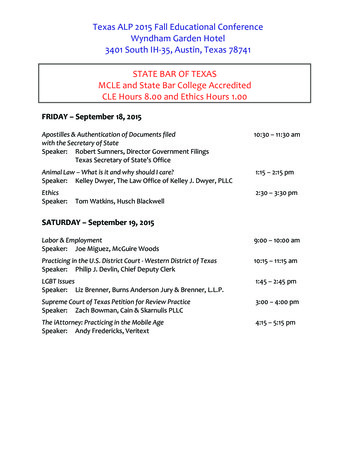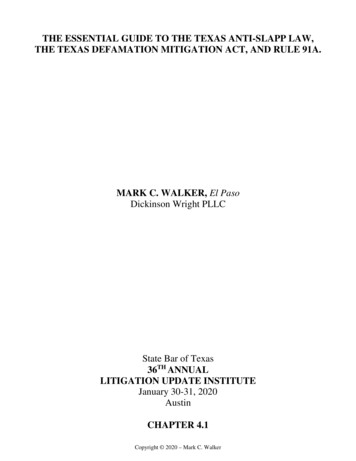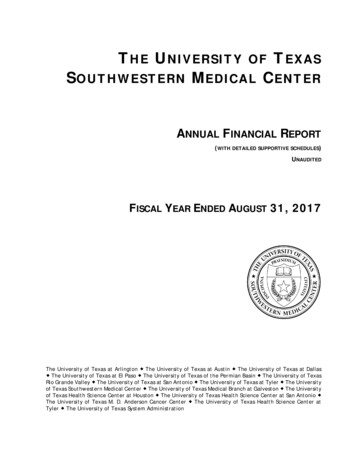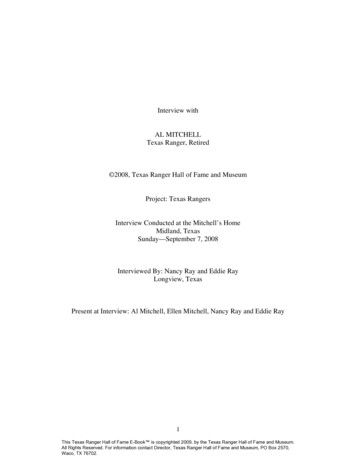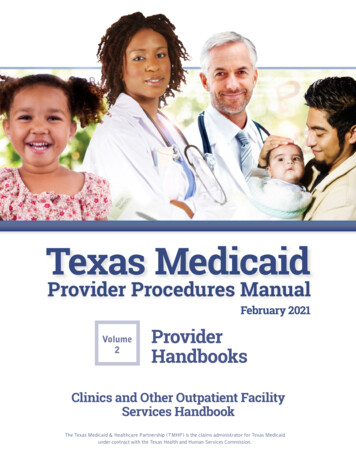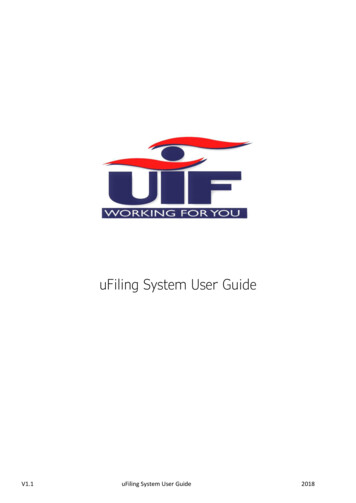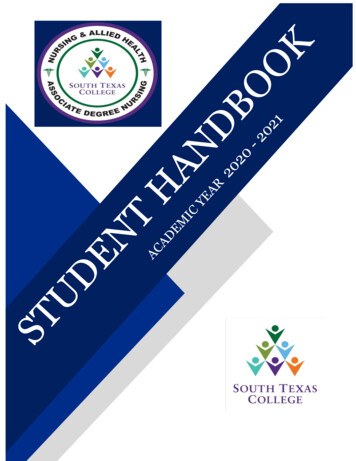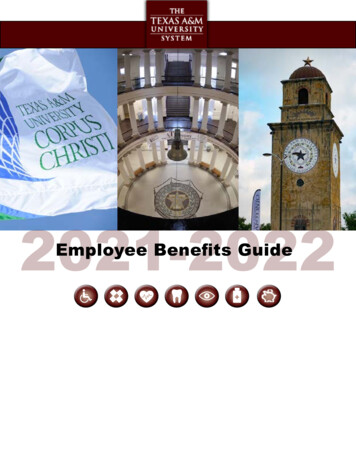
Transcription
Employee Benefits Guide
The Texas A&M University System is committed to offering itsemployees a comprehensive benefits package at a competitive cost. Thispackage includes medical, dental, vision, life insurance, AccidentalDeath & Dismemberment, Long-Term Disability, Flexible SpendingAccounts, Employee Assistance Programs, retirement, and various worklife benefits such as our wellness program.As part of this commitment, we provide you withaccess to a variety of tools and resources — includingthis Benefits Guide — to help you make informedbenefits decisions.In addition to this guide, the following resourcescan be found on the System Benefits Administrationwebsite: Plan description booklets for most insuranceprograms. Links to sites for the insurance carriers and otherbenefit plan providers. Most forms and benefit publications, which can bedownloaded and printed. Additional information about A&M Systemretirement programs.At the back of this handbook is a list of websites andphone numbers for each plan, as well as contactinformation for your campus or agency HumanResources office.Table of ContentsHow Your Benefits WorkBenefits At-A-Glance3Understanding Benefits Lingo4Benefit Eligibility and Coverage Information6Proof of Eligibility6Dependent Documentation7Benefits EnrollmentCosts and Premiums12Qualifying Life Events13Qualifying for COBRA14Medical Plans Overview15A&M Care Plan18A&M Care 65 Plus Plan19J Plan21Graduate Student Employee Health Plan26Optional Plans29Retiree Medical Coverage28Dental30Vision33Life34AD&D38Long-Term Disability40Flexible Spending Accounts42Retirement Programs45Other Programs48Monthly Premiums50Premium Worksheet54Privacy Notices56
Benefits At A GlanceRight for your family, right for you.Benefit TypeOptionsDental PlansDelta Dental PPODeltaCare USA HMOVision PlansSuperior VisionFlexible Spending AccountHealth Care Spending AccountDependent Day Care Spending AccountLifeBasic LifeAlternate Basic LifeOptional LifeSpouse LifeChild LifeAD&D (Accidental Death & Dismemberment)AD&D PlanLong-Term DisabilityOptional Long-Term DisabilityRetirement ProgramsTeacher Retirement System of Texas (TRS)Optional Retirement Program (ORP)Tax-Deferred Account Program (TDA)Texa aver Deferred Compensation Plan (DCP)Wellness and Work/Life SolutionsComPsych GuidanceResourcesWellness ProgramHinge HealthOmada for Pre-diabetes and Pre-hypertensionLivongo for Diabetes and HypertensionOvia Maternity and Women’s HealthWondr HealthMedical Second Opinion Advice2nd.MDVirtual Visits - TelemedicineBCBS with MDLIVEAHP Live Care - Grad PlanMedical Plans3A&M Care PlanJ PlanA&M Care 65 PLUS PlanGraduate Student Employee Health Plan
Understanding Benefits LingoKnowing and understanding your benefits is important to choosing the path that is best for you and your family.These definitions will help you understand your coverages and help you make informed decisions.Brand Name MedicationsDrugs that are patented, manufactured and distributed by only one pharmaceutical manufacturer.Coinsurance or Cost SharingA percentage of the cost of a medical or dental expense that is shared between you and the plan after youpay your deductible. For example, the A&M Care plan’s share of most expenses is 80% and your share(coinsurance amount) is 20%.Copayment (Copay)A set dollar amount you pay toward an expense, such as an office visit or prescription drug. The remaining costis covered by the plan.COBRAThe Consolidated Omnibus Budget Reconciliation Act allows you and/or covered dependents to extendmedical, dental and/or vision coverage beyond the date on which eligibility would normally end. You pay the fullpremiums plus a 2% administrative fee for this continuation coverage.DeductibleThe amount of money you must pay toward medical, prescription drug or dental expenses for each familymember each year before some medical, drug or dental benefits are reimbursable. After you have met yourdeductible, future expenses are covered at the coinsurance or copayment amount. Copayments do not counttoward the deductible. You can submit claims for reimbursement of deductible, coinsurance and copaymentamounts through a Health Care Flexible Spending Account.FSA (Flexible Spending Account)A FSA is set up through an employer plan. It lets you set aside pre-tax money for most out-of-pocket medical,prescription drug, dental and vision costs and for dependent daycare. FSA funds must be used by the end ofthe year.Generic MedicationsDrugs that are manufactured, distributed and available under a chemical name without patent protection. Ageneric drug must have the same active ingredient as its brand name counterpart. Generic drugs typically costless than brand name drugs.Health AssessmentA health survey that measures your current health, your health risks and quality of life.Non-Preferred or Non-Formulary DrugsBrand name medications that are not on the Preferred List because less expensive and equally effectivealternatives are available. Non-Preferred medications require a higher copayment.4
Out-of-pocket MaximumGenerally, the most you will have to spend each plan year for each covered family member. The annualdeductible, copayments and coinsurance are counted towards this maximum. Once you have met the out-ofpocket maximum on yourself or a covered dependent, the plan pays 100% of most remaining expenses for youand your covered dependent for the rest of that plan year.Primary Care Physician (PCP)Under the A&M Care and Graduate Student Health plans, a PCP is a general or family practitioner, an internalmedicine doctor, a pediatrician, an OB/GYN, or a behavioral health practitioner. Although it is not required, thisprovider usually coordinates your medical care and provides referrals to specialists.Preferred or Formulary DrugsA list of drugs that are periodically reviewed and updated by a committee of physicians, pharmacist and otherhealth professionals for effectiveness and cost effectiveness. Each plan has its own Preferred Drug List. Often,brand drugs that have generics available will not be on the formulary list to encourage individuals to purchasethe less expensive generic.Reasonable and Customary Fee/Allowed AmountThe lower of the actual charge for services or supplies, or the usual charge of most other doctors, dentists orother providers of similar training or experience in the same geographic area for the same or similar services orsupplies as determined by the medical carrier.Network Provider/In-network ProviderA healthcare provider who is part of a plan’s network.Non-network Provider/Out-of-network ProviderA healthcare provider who is not part of a plan’s network. Costs associated with out-of-network providers maybe higher or some costs may not be covered by your plan. Consult your plan for more information.5
Benefit Eligibility and Coverage InformationEmployee CoverageYour eligibility for a particular benefits package depends on the type of job you have, the percentage of timeyou work and the length of your appointment.Eligibility You work at least 50% time for at least 4 1/2 months Your appointment is expected to continue for a term of at least 4½months, AND You are eligible for retirement benefits as a member of the TeacherRetirement System of Texas (TRS), or you are graduate studentemployee You are also eligible if you are a graduate student fellowDependent CoverageYou may enroll any or all of your eligible dependents in medical, dental, vision, dependent life and/or AD&D, ifyou have that coverage on yourself. Only the dependents you list in Workday will be covered. However, if youelect family AD&D coverage, all eligible dependents will automatically be covered under that plan. For moreinformation on eligible dependents, contact your Human Resources office.Eligible Dependents include: Your current spouse; Your common-law marriage partner, as defined by state law; Your dependent children up to age 26 (regardless of marital status); including a natural child, stepchild,a legally adopted child, grandchildren you claim on your income tax, or a child for whom you or yourspouse are the legal guardian. Managing Conservatorship/Legal Guardian dependents up to age 18 unless accepted court order statesotherwise.Examples of dependents who are not eligible for coverage include: A former spouse, or former stepchildren Siblings An elderly parent.Proof of EligibilityYou must provide proof of eligibility to enroll any dependents. In order for your dependents to have coverage,their dependent documentation must be submitted and approved before their effective date of coverage.This paperwork is required not only to support the coverage of eligible dependents but also to support a midyear qualifying Life Event such as marriage or birth of a child. For medically incapacitated dependents, medicalfiles documenting incapacitating condition and dependency must be submitted within 31 days of initial eligibilityfor enrollment of an incapacitated dependent.6
Dependent DocumentationIn order for your dependents to have coverage, their dependent documentation must be submitted andapproved before their effective date of coverage. Foreign documents other than marriage license or birthcertificate should be accompanied by an English translation.You can upload dependent documentation in HRConnect Legacy after enrollment in Workday, or submit it toyour Human Resources office. Documentation needed to qualify your dependents for coverage:Legal Marriage DocumentsIf you are legally married OR legally married and physically separated you will need: Your most recent Federal Tax Return (financial information can be redacted), OR Marriage Certificate AND Proof of Joint Ownership dated less than six months old. Recommendationsinclude Texas Car Insurance Document, assignment of a durable property power of attorney or healthcarepower of attorney, a mortgage or bank statement, or property tax bill. Documents must include both theemployee’s name and the spouse’s name.If within two years of marriage, then only the marriage certificate is required.Common Law Marriage DocumentsIf you are legally married by a Common Law Marriage you will need: Your most recent Federal Tax Return(s) showing that you are married filing jointly or separately, OR Texas Declaration of Informal/Common Law Marriage from the County where the marriage was recognizedor recorded AND Proof of Joint Ownership dated less than six months old. Recommendations includeTexas Car Insurance Document, assignment of a durable property power of attorney or healthcare power ofattorney, a mortgage or bank statement, or property tax bill. Documents must include both the employee’sname and the spouse’s name.Biological Child DocumentsBirth Certificate of Biological Child listing the employee as mother or father, OR Documentation on hospitalletterhead indicating the birth date of the child or children (if under 6 months old) will be accepted as temporaryenrollment and must be followed by the birth certificate when received.Step Child DocumentsChild’s Birth Certificate showing the child’s parent is the employee’s spouse, AND Marriage Certificate showinglegal marriage between the employee and the child’s parent.Adopted Child DocumentsThe documents will depend on the current stage of the adoption. Official court/agency placement papers fora child placed with you for adoption (initial stage), OR Official Court Adoption Agreement for an Adopted Child(mid-stage), OR Birth Certificate (final stage).Disabled Child age 26 or olderA doctor’s statement regarding the physical or mental condition of the dependent, whether the dependent isable to maintain self-sustaining employment and whether the condition occurred before the child reached age26.In order for the disabled child to be enrolled in coverage when he/she is age 26 or older, the followingdocumentation must be submitted either before the child/grandchild reaches age 26 (if he/ she is currentlycovered) or when the child begins the enrollment process (if he/she is currently not covered):1. For medical coverage: Blue Cross and Blue Shield’s “Dependent Child’s Statement of Disability,” should bemailed to: Sr. Medical Underwriter, Blue Cross and Blue Shield of Texas, Small Group Medical Underwriting,P.O. Box 655730, Dallas, TX 75265-5730, Attn: Medical Underwriting.7
2. For optional coverage only: the documentation should be sent to System Benefits Administration who willapprove or deny coverage based on the medical information received.Grandchild DocumentationTax return showing claimed grandchild (financial information can be redacted).Foster Child DocumentationOfficial Court or Agency Placement papers.Legal Guardianship DocumentationCourt order establishing guardianship of a child. Eligible up to age 18 unless court order defines otherwise.Managing Conservatorship DocumentationCourt order establishing managing conservatorship of a child. Eligible up to age 18 unless court order definesotherwise.Retiree CoverageUnder current state law, you are eligible for A&M System insurance coverage as a retiree when: You are at least age 65 and have at least 10 years of service credit, or your age plus years of serviceequal at least 80 and you have 10 years of service credit, You have 10 years of service with the A&M System, and The A&M System is your last state employer.In some cases, you may combine years of service with other Texas state employers to meet the 10 years ofservice rule.For information on “grandfathered” retirement rules for employees working for the A&M System prior to9/1/2003, contact your Human Resource office.If you are in TRS, you must be receiving TRS annuity payments to be eligible for health and other benefits.8
Benefit EnrollmentEnrollmentYou must enroll in benefits within 45 days from thedate you become eligible. You have some options onwhen your coverage begins: You can elect coverage for you and yourdependents to take effect on your hire date if youenroll before, on, or within seven days after yourhire date You can elect for coverage to begin on the firstof the month following hire/initial eligibility if youenroll before the end of the month of your hire/initial eligibility. If you enroll beyond the seventh day after yourhire date, but during your 45-day enrollmentperiod, your coverage will take effect on youremployer contribution eligibility date (the first ofthe month after your 60th day of employment).Coverage Start DateTime Period to EnrollCurrent EmployeeOpen Enrollment is held each year during the monthof July. During this time you may add, change, or dropcoverage for yourself and/or your dependents usingWorkday. Elections and/or changes made during thistime will be effective the following September 1, or ifevidence of insurability is required and approvedafter September 1, the first of the month following theapproval.Date of hire/initialeligibility7 days from date ofhire/initial eligibilitydateIf no changes are made during Open Enrollment,benefits will automatically roll over to the next planyear, with the exception of any Flexible SpendingAccounts and life insurance coverage reductions dueto age.First of the monthfollowing date of hire/initial eligibilityEnd of the month inwhich you are hired/initially eligibleIf you do not need medicalcoverageEmployer contributioneligibility date (firstof the month afteryour 60th day ofemployment)45 days from date ofhire/initial eligibilityYou will pay the total monthly premium if you electbenefits to start before your employer contributioneligibilty date.You may cover your dependents beginning on yourhire date if you enroll before, on, or within seven daysafter your hire date, or you may delay the start of theircoverage. If you enroll yourself or your dependentsimmediately, you must pay the full month’s premiumeven if coverage begins partway through the month.You may also have your coverages begin beforeyour employer contribution eligibility date, but haveyour dependents’ coverages begin on your employercontribution eligibility date.If you do not enroll in health coverage and do not9waive health coverage by the end of your 45-dayenrollment period, you will automatically be enrolledin a basic package with employee-only coverageon your employer contribution eligibility date. Thisbasic package includes the A&M Care medical planfor you, Basic Life coverage for you and any eligibledependent children and 5,000 in Accidental Deathand Dismemberment (AD&D) coverage for you.You pay any cost that is greater than the employercontribution.If you do not need A&M System medical coverageand you certify that you have other medical coverage,you may use up to half of the employee-only employercontribution to pay for other coverage. For example,if your spouse works for the A&M System, you maychoose to be covered under your spouse’s medicalplan and use your employer contribution for dentaland vision coverage for you and your spouse.You can also use your employer contribution topay for Alternate Basic Life, Accidental Death andDismemberment, A&M Dental or DeltaCare USADental HMO, Vision and Long-Term Disability, in thatorder. You may not use the employer contribution topay for Optional Life or Dependent Life. If you areenrolled in medical coverage from the University ofTexas System or the Employees Retirement System,you are not eligible for an additional employercontribution. You can receive an employer contributionfrom only one Texas state agency or institution ofhigher education.
If the employer contribution is used for LTD and youreceive LTD benefits, part or all of those benefitsmay be taxable income; if you pay the premium thenthe benefits are not taxable. If you do not want theemployer contribution applied to your LTD coverage,you can enroll to pay for it yourself, or waive thecontribution as you complete your online enrollment.If you both work for the A&MSystemIf you and your spouse are both employed by theA&M System:How To Enroll OnlineTo eroll through Workday:Log in to Single Sign On (SSO) at https://sso.tamus.edu using your Universal Identification Number (UIN)and your SSO password. Once you’re logged on, clickon Workday. Then: You can be covered as an employee on somecoverages and as a dependent on others butyou cannot be covered as an employee and adependent on the same coverages, except onAD&D. During Open Enrollment: Select the OpenEnrollment task in your Workday inbox and followthe steps to elect coverages. If you do not wantto make any changes, you can leave your currentelections selected, and submit the task. Children can be covered as dependents by eitherspouse, but not by both, except on AD&D. During a Life Event: Select the Benefits workletfrom the Workday Dashboard and click on“Benefits” in the Change column. You will beasked to select a Reason for the change. Both spouses may set up Flexible SpendingAccounts and use them to pay dependentexpenses. Each spouse may contribute up to 2,750 to a Health Care Flexible SpendingAccount, but the total both spouses maycontribute to Dependent Day Care FlexibleSpending Accounts is 5,000. You can each enroll separately in medicalcoverage and receive separate employercontributions. Or, one of you can enroll in medical and cover theother as a dependent on medical. If you do this,the employee covered as a dependent will receivehalf of the employee-only employer contribution,which can be used to purchase other coveragesfor the employee, spouse and/or family. To becovered under different medical plans, you musteach enroll as employees. A spouse who iscovered on medical as a dependent is not eligiblefor Basic Life coverage. If you elect Alternate Basic Life or Optional Life onyourself, you may not be covered by your spouseon Spouse Life. You may elect employee coverage for AD&D andbe covered as a dependent on your spouse’sfamily AD&D coverage, but your benefit will not bemore than the maximum for which you are eligibleunder employee coverage. If both you and yourspouse elect family AD&D coverage, your childrenmay be covered under both plans. However, youwill not receive more than 25,000 total benefit foreach child.10For more information, read the A&M System brochure:“When You and Your Spouse Both Work for theA&M System” available on the A&M System Benefitswebsite. New employees should refer to the NewEmployee Booklet on the A&M System BenefitsAdministration website for more information aboutthe initial enrollment process.Additional information you need to enroll: If adding dependents to your coverage, beforeelecting coverage, enter the dependent’s namesand other required information under Dependentsin the Benefits Worklet. After entering dependents, you will begin theenrollment task. You must then add your dependents to thecoverages you select. Designate your beneficiaries for BasicLife, Optional and Accidental Death andDismemberment coverage, if elected. Update tobacco user status for yourself and yourspouse, if covered on your plan.Before exiting the system, click “submit” to submityour final choices for processing.
Costs and PremiumsEmployer ContributionYou will begin receiving a monthly employer contributionthe first of the month after your 60th day of employment. Ifyou are transferring with no break in service from anotherTexas state agency or institution of higher education, yourcontribution will begin as soon as you enroll in coverage.Your employer contribution amount will depend onwhether you are a full-time (30 hours/week or more) orpart-time (20-29 hours/week) employee and whetheryou enroll dependents. Premiums listed in this guideinclude the total premium and your cost after theemployer contribution begins.Pretax PremiumsWhen you enroll in medical, dental, vision or AD&Dcoverage, your share of the premium for you and yourcovered dependents will be deducted from your paycheckbefore your federal income and Social Security taxes arecalculated.Summer PremiumsFor 9-11 month, full-time monthly paid positions,premiums are prorated so that you pay for 12 monthsof premiums in 9 months. This means that you pay for12 months of premiums by May 31. You do not haveto pay premiums during the summer and you will havecoverage, unless you are terminating employment.In this case, you will receive a refund for the summermonths.If you elect for coverage to begin before youremployer contribution eligibility date, you will haveto pay the total monthly premium until your employercontribution eligibility date.If you are a new employee and your insurance coveragebegins after September 1, you do not have proratedpremiums during your first year of employment; yoursummer premiums will be deducted from your Maypaycheck.Tobacco user and wellness charges, if applicable,are 40/month since they are prorated. If you have awellness credit, that is prorated as well. All rates areinclusive of the wellness premium. Premiums increaseby 40 if you or your spouse is a tobacco user.For 9-11 month bi-weekly paid and/or part-timeemployees, and if your employer has a reasonableexpectation to continue your employment in the fall,11your summer premiums (June, July and August) willbe deducted from your May paycheck. You will receivethe employer contribution for these months unless youterminate employment before September 1. You willreceive more information about this in April, if applicable.12 Over 9 AppointmentsThe expected premium due each month, over 9months, is based on an assumed full plan year ofthe same coverage. If coverage changes mid-year,you may be entitled to a refund or owe an additionalpremium. Your Benefits Partner will calculate youradjusted premium and communicate with the Payrolldepartment if any Life Events take place whichresult in a change in coverage. These may includeadding or removing a dependent due to birth of achild or divorce in the middle of a plan year. 12 over9 appointments are not available to graduate studentemployees.Payroll DeductionsIf you are paid monthly, premiums deducted from yourpaycheck are for your insurance coverage during theprevious month. For example, the premiums deductedfrom your October 1 paycheck are for your Septembercoverage. If you are paid bi-weekly, your premiums will bededucted twice per month (24 times per year).Billing or Bank draftIf you are not working, and are paying premiums throughbilling or bank draft, you are being billed for coverage forthe following month.Tobacco User PremiumDesignate a tobacco user status for yourself and yourspouse, if he/she is enrolled in medical coverage orDependent Life. An additional monthly premium chargefor medical coverage of 30 for an employee or acovered spouse will be deducted for those who usetobacco products. You must be tobacco-free for at least3 months to be considered a non-tobacco user. If youdo not provide tobacco status information, the defaultdesignation for you and a covered spouse will be atobacco user. The tobacco premium does not apply to theGraduate Student Employee Plan.
Qualifying Life EventsChanges can be made to your benefits during the Open Enrollment period each July. Otherwise, you can onlychange your medical, dental, vision or spending account coverages during the plan year within 60-days of aQualifying Life Event. The changes you make to your coverage(s) must be consistent with the Qualifying LifeEvent. For example, if you have a new baby, you can add the baby to your health coverage, but you cannot dropyour spouse from health coverage.If you do not make your changes within 60-days of the Life Event, you cannot change coverage until the nextOpen Enrollment in July to be effective the following September 1.Qualifying Life Events include: Employee’s marriage or divorce or death of employee’s spouse Birth, adoption or death of a dependent child Change in employee’s, spouse’s or dependent child’s employment status that affects benefit eligibility, suchas leave without pay Child becoming ineligible for coverage due to reaching maximum age Change in the employee’s, spouse’s or a dependent child’s residence that affects eligibility for coverage Employee’s receipt of a qualified medical child support order or letter from the Attorney General ordering theemployee to provide (or allowing the employee to drop) medical coverage for a child Changes made by a spouse or dependent child during his/her open enrollment period with another employer The employee, spouse or dependent child becoming eligible or ineligible for Medicare or Medicaid Significant employer or carrier initiated changes, such as, significant premium increase, coinsuranceincrease or cancellation of the employee’s, spouse’s or dependent child’s coverage The employee or dependent reaching the lifetime maximum for all benefits from a non-A&M System medicalplan (medical plan changes only) Change in day care costs due to a change in provider, change in provider’s fees (if the provider is not arelative) or change in the number of hours the child needs day care (for Dependent Day Care SpendingAccounts) The employee or dependent child loses coverage under the state Medicaid or CHIP plans or becomeseligible for premium assistance under the Medicaid or CHIP.Documentation is required for Life Event changes:Benefit Event TypeDocumentation RequiredBirth/AdoptionMarriageChange due to Spouse OpenEnrollmentSee Dependent Documentation on Page 7See Dependent Documentation on Page 7Copy of spouse's enrollment plan notification of add or drop,showing effective date and corresponding coverages, and enrolleddependentsReceipt or notice of change from providerDependent Daycare Provider Cost/Hour ChangeGain Other CoverageLoss of Other Coverage12Medicaid ChangeMedical Support OrderSpouse Becoming Medicare EligibleCopy of enrollment confirmation showing effective date and enrolledcoverages, and enrolled dependentsCopy of loss of coverage announcement showing effective date andcorresponding coverages, and enrolled dependentsCopy of Medicaid announcementCopy of Medical support orderCopy of spouse Medicare Card
Qualifying For COBRAIf you or your covered dependents lose eligibility for benefits coverage due to a COBRA qualifying event, youand/or your dependents will be able to continue coverage for medical, dental, vision, and/or a Health CareFlexible Spending account if you are enrolled at the time of the qualifying event. The following are qualifyingevents: The death of a covered employeea covered enployee’s termination of employment or reduction of the hours of employmentdivorce or legal separation from the covered employee, ora dependent child ceasing to be a dependent under the generally applicable requirements of the plan.COBRA coverage is the same coverage provided to all other participants, but the premiums are 102% of thetotal premiums and there is no employer contribution.SurvivorsSurvivor(s) of deceased employees or retirees may be eligible for coverage beyond the coverage extendedthrough COBRA regulations. Coverage in all cases depends on the survivor having been covered at the time ofthe employee’s/retiree’s death. Survivors of A&M System employees or retirees may continue medical, dentaland/or vision coverage only.The total premium for survivors is the same as those for active employees, but survivors are not eligible for theemployer contribution.Indefinite coverage for survivor(s) is available if: the deceased was a retiree of the A&M System, orthe deceased was an employee of any age with at least five years of TRS- or ORP-creditable service,including at least three years of service with the A&M System, and his/her last state employment was withthe A&M System.If the deceased was a disability retiree with less than five years of service, the survivor is eligible for benefitsfor the number of months equal to the months of service of the deceased retiree. If this is less than 36 months,the survivor could elect COBRA for the remaining months (36 months from the date of death.)Spouse survivor coverage can continue i
Death & Dismemberment, Long-Term Disability, Flexible Spending Accounts, Employee Assistance Programs, retirement, and various work-life benefits such as our wellness program. As part of this commitment, we provide you with access to a variety of tools and resources — including this Benefits Guide — to help you make informed benefits decisions.

